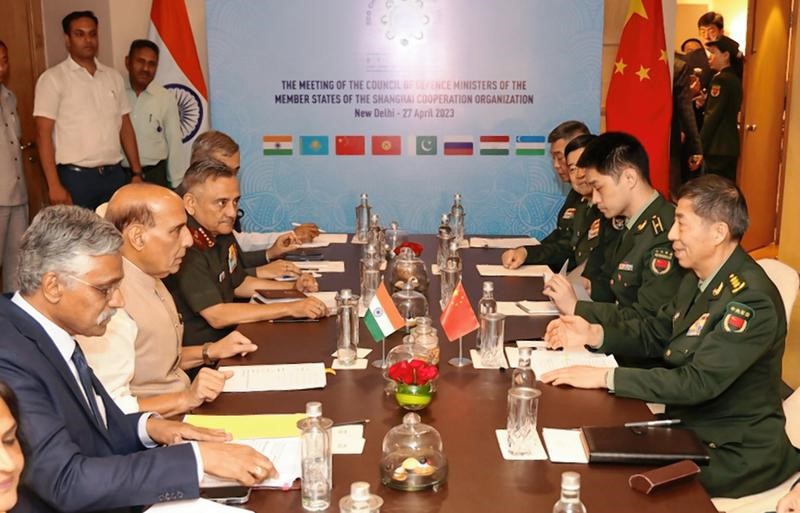Description

Disclaimer: Copyright infringement not intended.
Context
- The violation of existing agreements has eroded the entire basis of bilateral relations, Defence Minister Rajnath Singh told his Chinese counterpart. This is the first high-level military visit from China since the start of the Ladakh stand-off in April 2020.
Details
- Just five days before the bilateral discussions, the two countries held the 18th round of Corps Commander talks as part of continuing dialogue to resolve the stand-off.
- The two Ministers had frank discussions about the developments in the border areas as well as bilateral relations.
- Indian defence minister categorically said military cooperation between the two countries can progress “only” if peace and tranquillity is established on the border.
Border clashes
- Since the 1950s, India and China have repeatedly erupted in conflict over a long-running border dispute.
- In addition, the strategic alliance between China and Pakistan and the vigorous arming of the Pakistani forces make India face the threat of a two-front war.

Demand for status quo
- So far since the standoff began, Indian and Chinese troops have disengaged from the northern and southern banks of the Pangong Tso, Gogra and the Hot Springs, while tensions remain in Depsang Plains and Demchok which India calls as “legacy issues.”
- India has also demanded that troops go back to their original positions as it existed before the standoff began by way following a status quo even as both sides will move to bring back the additional troops as well as the weaponry that have all been pushed in the border areas due to the rising tensions there.
Military exercises
- China and India conduct a joint military exercise called 'Exercise Hand–in–Hand'.
- The exercise began in 2007.
- While bilateral military exercises between India and China have ceased over the past few years, India is still accepting invitations from Russia for multilateral armed forces exercises that also happen to host Chinese soldiers.

India-China border pacts
- India and China have five border pacts, dating back to 1993. These agreements are:
-
- 1993 Agreement on Maintenance of Peace and Tranquillity along the Line of Actual Control in the India-China Border Areas
- 1996 Agreement on Confidence Building Measures in the Military Field along the LAC
- 2005 Protocol on Modalities for the Implementation of the Confidence Building Measures in the Military Field along the LAC
- 2012 Agreement on the Establishment of a Working Mechanism for Consultation and Coordination on India-China Border Affairs and
- 2013 Border Defence Cooperation Agreement.
Visit of the then Prime Minister Rajiv Gandhi to China in December 1988, established the Joint Working Group (JWG), the groundwork for defence cooperation and military engagement.
1993 Agreement on the Maintenance of Peace and Tranquility along the Line of Actual Control in the Sino-Indian Border
- This agreement provides the “framework for border security between the parties until final determination is made regarding border demarcation.”
- The parties agree to keep “military forces in the areas along the line of actual control to a minimum level” and “reduce troop levels” compatible with friendly and good relations between them.
- They also agree to carry out confidence-building measures along the LAC control, including by providing prior notification of “military exercises of specified levels near the line of actual control permitted under this Agreement.”
1996 Agreement between the Government of the Republic of India and the Government of the People’s Republic of China on Confidence-Building Measures in the Military Field along the Line of Actual Control in the Sino-Indian Border
- The agreement allows for military disclosure when the parties are undertaking border exercises and for the reduction of troop levels in the border areas.
- It also allows the parties to observe and inspect troop movements in each other territory upon invitation.
- In this agreement, the two sides agreed to reduce or limit their military forces within mutually-agreed geographical zones along the LAC.
- It specifies the major categories of armaments to be reduced or limited: “combat tanks, infantry combat vehicles, guns (including howitzers) with 75 mm or bigger calibre, mortars with 120 mm or bigger calibre, surface-to-surface missiles, surface-to-air missiles and any other weapon system mutually agreed upon.”
- It also stipulates that neither side shall open fire, cause bio-degradation, use hazardous chemicals, conduct blast operations or hunt with guns or explosives within two kilometers from the line of actual control.
2005 Protocol on the Modalities for the Implementation of Confidence-Building Measures in the Military Field along the Line of Actual Control in the Sino-Indian Border
- The Protocol seeks to implement previous agreements and “agreed on modalities to implement the confidence building measures including through procedures for exchange of information regarding troop movements and the conduct of bi-annual meetings on border issues. They also agreed to resolve any agreement violation or need for clarification through diplomatic channels.”
2005 Agreement between the Government of the People’s Republic of China and the Government of the Republic of India on the Political Parameters and Guiding Principles for the Settlement of the China-India Boundary Question
- Article 1 states that the differences on the boundary question should not be allowed to affect the overall development of bilateral relations.
- The two sides will resolve the boundary question through peaceful and friendly consultations.
-min.jpg)
2012 Establishment of a Working Mechanism for Consultation and Coordination on China-India Border Affairs
- The two sides agree to establish the WMCC to deal with important border affairs related to maintaining peace and tranquility in the India-China border areas.
- The WMCC will be headed by a Joint Secretary level official from the Indian MEA and a Director General level official from the Chinese MFA and will be composed of diplomatic and military officials of the two sides.
2013 Border Defense Cooperation Agreement between India and China
- The 10-article agreement enumerates several mechanisms to reduce misunderstandings and improve communications between the two countries along their disputed border.
- Article VI explicitly prohibits one side from actively following or tailing the patrols of another side.
- Articles VI, VII, and VIII each explicitly outline procedures for resolving disputes in “areas where there is no common understanding of the line of actual control.
MUST READ ARTICLE:
India China border talks: https://www.iasgyan.in/daily-current-affairs/india-china-border-talks-1
|
PRACTICE QUESTION
Q) India and China have five border pacts, dating back to 1993. Discuss in brief the major provisions of each of these pacts. (250 words)
|
https://epaper.thehindu.com/ccidist-ws/th/th_delhi/issues/34178/OPS/GGAB5PFGJ.1+G4JB5PJHE.1.html












